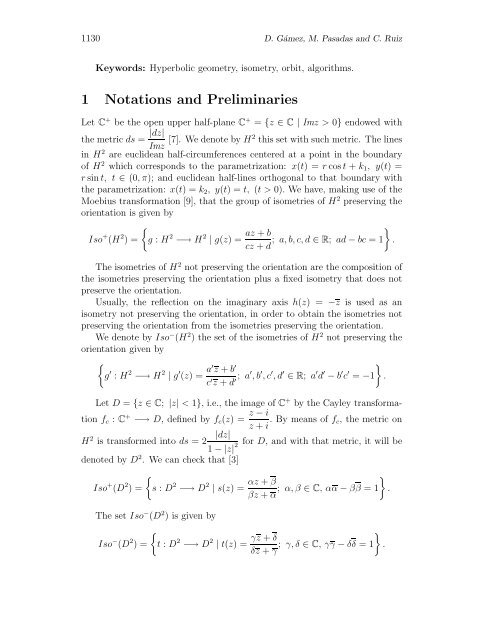Characterizations of the Isometries and Construction of the Orbits in ...
Characterizations of the Isometries and Construction of the Orbits in ...
Characterizations of the Isometries and Construction of the Orbits in ...
You also want an ePaper? Increase the reach of your titles
YUMPU automatically turns print PDFs into web optimized ePapers that Google loves.
1130 D. Gámez, M. Pasadas <strong>and</strong> C. Ruiz<br />
Keywords: Hyperbolic geometry, isometry, orbit, algorithms.<br />
1 Notations <strong>and</strong> Prelim<strong>in</strong>aries<br />
Let C + be <strong>the</strong> open upper half-plane C + = {z ∈ C | Imz >0} endowed with<br />
<strong>the</strong> metric ds = |dz|<br />
Imz [7]. We denote by H2 this set with such metric. The l<strong>in</strong>es<br />
<strong>in</strong> H 2 are euclidean half-circumferences centered at a po<strong>in</strong>t <strong>in</strong> <strong>the</strong> boundary<br />
<strong>of</strong> H 2 which corresponds to <strong>the</strong> parametrization: x(t) =r cos t + k 1 , y(t) =<br />
r s<strong>in</strong> t, t ∈ (0,π); <strong>and</strong> euclidean half-l<strong>in</strong>es orthogonal to that boundary with<br />
<strong>the</strong> parametrization: x(t) =k 2 ,y(t) =t, (t >0). We have, mak<strong>in</strong>g use <strong>of</strong> <strong>the</strong><br />
Moebius transformation [9], that <strong>the</strong> group <strong>of</strong> isometries <strong>of</strong> H 2 preserv<strong>in</strong>g <strong>the</strong><br />
orientation is given by<br />
{<br />
Iso + (H 2 )= g : H 2 −→ H 2 | g(z) = az + b<br />
}<br />
cz + d ; a, b, c, d ∈ R; ad − bc =1 .<br />
The isometries <strong>of</strong> H 2 not preserv<strong>in</strong>g <strong>the</strong> orientation are <strong>the</strong> composition <strong>of</strong><br />
<strong>the</strong> isometries preserv<strong>in</strong>g <strong>the</strong> orientation plus a fixed isometry that does not<br />
preserve <strong>the</strong> orientation.<br />
Usually, <strong>the</strong> reflection on <strong>the</strong> imag<strong>in</strong>ary axis h(z) = −z is used as an<br />
isometry not preserv<strong>in</strong>g <strong>the</strong> orientation, <strong>in</strong> order to obta<strong>in</strong> <strong>the</strong> isometries not<br />
preserv<strong>in</strong>g <strong>the</strong> orientation from <strong>the</strong> isometries preserv<strong>in</strong>g <strong>the</strong> orientation.<br />
We denote by Iso − (H 2 ) <strong>the</strong> set <strong>of</strong> <strong>the</strong> isometries <strong>of</strong> H 2 not preserv<strong>in</strong>g <strong>the</strong><br />
orientation given by<br />
}<br />
{g ′ : H 2 −→ H 2 | g ′ (z) = a′ z + b ′<br />
c ′ z + d ; ′ a′ ,b ′ ,c ′ ,d ′ ∈ R; a ′ d ′ − b ′ c ′ = −1 .<br />
Let D = {z ∈ C; |z| < 1}, i.e., <strong>the</strong> image <strong>of</strong> C + by <strong>the</strong> Cayley transformation<br />
f c : C + −→ D, def<strong>in</strong>ed by f c (z) = z − i<br />
z + i . By means <strong>of</strong> f c, <strong>the</strong> metric on<br />
H 2 is transformed <strong>in</strong>to ds =2<br />
|dz|<br />
2<br />
for D, <strong>and</strong> with that metric, it will be<br />
1 −|z|<br />
denoted by D 2 . We can check that [3]<br />
Iso + (D 2 )=<br />
{<br />
s : D 2 −→ D 2 | s(z) = αz + β<br />
βz + α ; α, β ∈ C, αα − ββ =1 }<br />
.<br />
The set Iso − (D 2 ) is given by<br />
{<br />
Iso − (D 2 )= t : D 2 −→ D 2 | t(z) = γz + δ<br />
}<br />
δz + γ ; γ,δ ∈ C, γγ − δδ =1 .
















